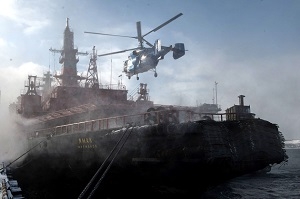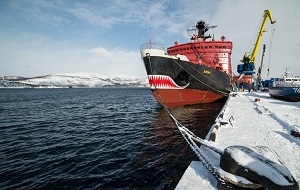Please activate JavaScript in your browser to use all interface options.
The Kara-Winter-2014 Ice Expedition Has Started Field Studies in the Artic Zone
09 April 2014
The Kara-Winter-2014 Expedition organized by the Arctic Research and Design Center (a joint venture of Rosneft and ExxonMobil) with expert support from the Arctic and Antarctic Research Institute Federal State Budget Institution left the Port of Murmansk on board the Yamal Ice-Breaker. This is going to be the largest ice expedition by the sea area coverage and duration (55 days) since the USSR collapse and it will study ice conditions of three seas: the Laptev, Kara, and East-Siberian Seas.
The studies are to be conducted in winter to determine the ice phases, the morphometric parameters of the ice cover, physical and chemical properties of the ice, ice ridges and stamukhas as well as weather and water mass conditions. For the first time iceberg drift will be studied by means of placing buoys on their bodies and engineering surveys will be conducted for the East Siberia and Laptev Seas.
To fulfill the above tasks, in addition to the 23 KT nuclear ice-breaker, the expedition will use satellites, a helicopter, an unmanned air drone, an underwater camera, buoys and a great number of research instruments. The equipment and technologies to be used by the expedition meet the world’s most modern requirements.
The expedition route runs along some of the least explored sea areas of the Arctic Ocean. The data obtained by the expedition will be interpreted and 3D models of ice formations will be built to support exploration and subsequent oil and gas field facility design activities. In addition, these data are of great scientific interest as no such studies have ever been conducted in the regions.
The expedition will also focus on biological studies and environmental protection measures. Marine mammal and bird observations will be conducted throughout the expedition, including on board the drone and helicopter. The data obtained will be used to develop environmentally friendly Arctic oil and gas exploration and production technologies.
All the works will be carried out considering exclusive standards of the partner companies regarding ecological and industrial security. Before the expedition started an additional audit of the Ice-Breaker compliant international IMCA standards has been conducted.
|
Background: Rosneft holds 46 licenses for offshore oil and gas exploration and production in the Russian Federation and is the largest Russian offshore subsoil user, its resources amounting to 318GOE. The Russian Arctic sedimentation basins are comparable with the world’s largest oil and gas regions in their total oil and gas potential. The company has already conducted a number of research expeditions in its offshore Arctic license areas. In August 2013 alone, those involved 13 various class vessels, 3 aircraft, a number of unmanned drones, subsea and above-water recording stations, satellite observation systems, ROVs. Leading Russian and international research and design organizations participated in the studies. |
Rosneft Information Division
April 9, 2014

-315xx70.png)



